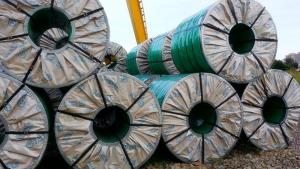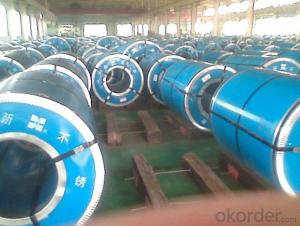Hot Rolled Stainless Steel Coil 430R
- Loading Port:
- Guangzhou
- Payment Terms:
- TT OR LC
- Min Order Qty:
- -
- Supply Capability:
- 10000 m.t./month
OKorder Service Pledge
OKorder Financial Service
You Might Also Like
Grade: | 400 Series | Standard: | JIS,AISI,ASTM,GB,DIN,EN | Length: | Coil |
Thickness: | 2.5mm,3.0mm, 4.0mm | Width: | 1000mm, 1219mm, 1240mm, 1500mm | Place of Origin: | China Mainland |
Brand Name: | CNBM | Model Number: | 430R | Type: | Coil |
Application: | Element Supports,Stove trim rings,Fasteners,Chimney Liners | Certification: | ISO | Certificate: | ISO9001:2008 |
Surface: | No.1 | Technique: | Hot Rolled | Experience: | About 20 years |
Stock Information: | In stock | Weight per coil: | 18-22 tons | Tolerance: | +/-0.1mm or less |
Model No.: | 430R |
|
|
|
|
Hot Rolled Stainless Steel Coil 430R No.1 Finish
Article | Hot Rolled Stainless Steel Coil 430R |
Grade | 400 series |
Specification | 1m, 1.2m, 1.5m |
Surface | No.1 |
Type | Sheet / Coil |
Width | 1000mm, 1219mm, 1240mm, 1500mm |
Thickness | 2.5mm,3.0mm, 4.0mm |
Brand name | CNBM |
Parking | seaworthy wooden pallets or wooden cases,in 20' or 40' container or as per customers' requirements |
Payment | 30% in advance,70% after shipping, or L/C at sight |
Delivery Time | Stock materials, within7-15 days after received the deposit of T/T or L/C |
Hot Rolled Stainless Steel Coil 430R No.1 Finish
Grade | C | Cr | Si | Mn | Mo | Ni | P | S |
| Max |
| Max | Max |
| Max | Max | Max |
430R | 0.12 | 16.0-18.0 | 0.75 | 1.00 | ----- | 0.6 | 0.04 | 0.03 |
- Q:What are the factors affecting the strength of 111 stainless steel strips?
- There are several factors that can affect the strength of 111 stainless steel strips: 1. Composition: The chemical composition of the stainless steel, including the amount of elements such as nickel, chromium, and molybdenum, can greatly impact its strength. Higher levels of these elements generally result in increased strength. 2. Heat treatment: The heat treatment process used during the manufacturing of the stainless steel strips can significantly affect their strength. Heat treatments like annealing, quenching, and tempering can alter the microstructure of the steel, leading to changes in its strength. 3. Cold working: The amount of cold working or deformation applied to the stainless steel strips during processing can impact their strength. Cold working can introduce dislocations and increase the material's strength, but excessive cold working can cause brittleness. 4. Grain size: The grain size of the stainless steel strips can influence their strength. Smaller grain sizes generally result in higher strength due to increased grain boundaries, which hinder dislocation movement. 5. Surface finish: The surface finish of the stainless steel strips can affect their strength, especially in terms of fatigue resistance. Smooth and polished surfaces tend to improve the fatigue strength of the material. 6. Environmental conditions: The environment in which the stainless steel strips are used can affect their strength. Factors such as temperature, humidity, and exposure to corrosive substances can lead to degradation of the material and reduce its strength over time. 7. Manufacturing process: The specific manufacturing process employed to produce the stainless steel strips can also impact their strength. Variables such as rolling techniques, annealing processes, and cold reduction methods can all influence the final strength of the strips. 8. Design considerations: The design of the stainless steel strips, including factors like thickness, width, and the presence of any surface defects or notches, can affect their strength. Proper design considerations should be taken to ensure optimal strength and performance. It is important to note that these factors are interrelated, and changes in one factor can influence the others. Consequently, manufacturers and engineers must carefully consider all these factors to achieve the desired strength and performance of 111 stainless steel strips.
- Q:What is the thermal expansion coefficient of stainless steel strips?
- The thermal expansion coefficient of stainless steel strips can vary depending on the specific grade of stainless steel being used. However, in general, stainless steel has a relatively low coefficient of thermal expansion compared to other materials. The coefficient of thermal expansion is a measure of how much a material expands or contracts when exposed to changes in temperature. Stainless steel typically has a coefficient of thermal expansion ranging from about 10 to 17 µm/m°C (micrometers per meter per degree Celsius). This means that for every degree Celsius increase in temperature, a stainless steel strip will expand by approximately 10 to 17 micrometers per meter in length. It is important to note that the exact coefficient of thermal expansion may vary depending on the specific alloy composition and heat treatment of the stainless steel. Therefore, it is recommended to consult the manufacturer's specifications or conduct specific testing to determine the precise thermal expansion coefficient of a particular stainless steel strip.
- Q:What are the common thickness and width combinations for stainless steel strips?
- Depending on the specific applications and industry requirements, the common thickness and width combinations for stainless steel strips can vary. However, there are some standard thickness and width combinations that are frequently used. Thin stainless steel strips usually have a thickness ranging from 0.01mm to 3mm, and the width typically falls between 5mm and 500mm. These thin strips are commonly found in industries such as electronics, automotive, and medical. Medium thickness stainless steel strips, on the other hand, can have a thickness ranging from 3mm to 20mm, with a width that can vary between 100mm and 1500mm. These medium thickness strips are often utilized in applications such as construction, architecture, and machinery manufacturing. Thicker stainless steel strips, which are commonly used in heavy industries like oil and gas, petrochemical, and shipbuilding, can have a thickness exceeding 20mm and a width wider than 1500mm. It should be noted that these thickness and width combinations are not exhaustive and can be adjusted based on the specific requirements of each project. Manufacturers and suppliers of stainless steel strips are often able to customize the thickness and width according to the customer's needs and specifications.
- Q:Can stainless steel strips be used in medical implant manufacturing?
- Yes, stainless steel strips can be used in medical implant manufacturing. Stainless steel is a commonly used material in the medical field due to its excellent corrosion resistance, high strength, and biocompatibility. It is often used for implants such as orthopedic devices, cardiovascular stents, and dental implants.
- Q:Are stainless steel strips resistant to pitting and crevice corrosion?
- Yes, stainless steel strips are highly resistant to pitting and crevice corrosion due to their composition and protective oxide layer.
- Q:Are stainless steel strips resistant to acetic acid?
- Yes, stainless steel strips are generally resistant to acetic acid.
- Q:Can 111 stainless steel strips be laser cut for precise shapes?
- Yes, 111 stainless steel strips can be laser cut for precise shapes. Laser cutting is a highly accurate and precise method that can be used to cut through various materials, including stainless steel. The laser beam used in the process is controlled by a computer, allowing for intricate and detailed cuts to be made with high precision. With the right settings and parameters, laser cutting can easily handle 111 stainless steel strips to create precise shapes according to the desired specifications.
- Q:What are the different surface patterns available for stainless steel strips?
- There are various surface patterns available for stainless steel strips, including brushed, mirror, embossed, perforated, and textured.
- Q:What are the common uses of stainless steel strips in the pulp and paper industry?
- The utilization of stainless steel strips is widespread in the pulp and paper industry owing to their remarkable characteristics and adaptability. Below are several typical applications of stainless steel strips in this sector: 1. Screens and filters: In various stages of the papermaking process, screens and filters made from stainless steel strips are employed. These aids in eliminating impurities and undesired particles from the pulp, guaranteeing the production of a top-notch final product. 2. Doctor blades: The manufacture of doctor blades also relies on the use of stainless steel strips. Doctor blades are critical components of paper machines as they remove excess water and chemicals from the paper during the drying process. The longevity and efficient performance of doctor blades are ensured by the corrosion resistance and durability of stainless steel. 3. Rollers and shafts: The creation of rollers and shafts utilized in paper machines frequently involves stainless steel strips. These rollers and shafts have a vital role in guiding the paper through different production stages, including drying, coating, and printing. Stainless steel's high strength and resistance to wear make it an excellent choice for these purposes. 4. Wires and mesh: Extensive usage of stainless steel strips can be observed in the production of wires and mesh used in paper machines. These wires and mesh aid in the formation and transportation of paper fibers, ensuring proper drainage and consistency. Stainless steel's corrosion resistance guarantees the durability and good condition of the wires and mesh, even when exposed to chemicals and moisture. 5. Pipelines and fittings: The construction of pipelines and fittings used for the transportation of fluids and chemicals within the pulp and paper industry also involves the application of stainless steel strips. Stainless steel's resistance to corrosion and high temperatures makes it a dependable choice for these applications, ensuring the safe and efficient flow of liquids throughout the production process. In conclusion, the durability, corrosion resistance, and versatility of stainless steel strips render them indispensable in the pulp and paper industry. From screens and filters to doctor blades and rollers, stainless steel strips play a pivotal role in ensuring smooth operations and the production of high-quality paper.
- Q:Can stainless steel strips be used for architectural canopies?
- Yes, stainless steel strips can be used for architectural canopies. Stainless steel is a highly durable and corrosion-resistant material, making it suitable for outdoor applications such as canopies. It provides a sleek and modern aesthetic, adding an elegant touch to architectural designs. Stainless steel strips can be easily formed and fabricated into various shapes and sizes, allowing for customized canopy designs. Additionally, stainless steel's strength and resistance to harsh weather conditions make it a reliable choice for long-lasting canopies.
1. Manufacturer Overview |
|
|---|---|
| Location | |
| Year Established | |
| Annual Output Value | |
| Main Markets | |
| Company Certifications | |
2. Manufacturer Certificates |
|
|---|---|
| a) Certification Name | |
| Range | |
| Reference | |
| Validity Period | |
3. Manufacturer Capability |
|
|---|---|
| a)Trade Capacity | |
| Nearest Port | |
| Export Percentage | |
| No.of Employees in Trade Department | |
| Language Spoken: | |
| b)Factory Information | |
| Factory Size: | |
| No. of Production Lines | |
| Contract Manufacturing | |
| Product Price Range | |
Send your message to us
Hot Rolled Stainless Steel Coil 430R
- Loading Port:
- Guangzhou
- Payment Terms:
- TT OR LC
- Min Order Qty:
- -
- Supply Capability:
- 10000 m.t./month
OKorder Service Pledge
OKorder Financial Service
Similar products
New products
Hot products
Hot Searches
Related keywords





























